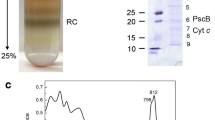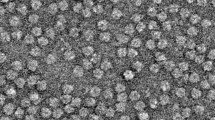Abstract
Effect of chemical oxidation by ferricyanide on bacteriochlorophyll a (BChl a) in the Fenna–Matthews–Olson protein (FMO) was studied using absorbance and fluorescence spectroscopy at ambient and cryogenic temperatures. Partially selective oxidation of pigments bound to the antenna complex was achieved and the probable absorption wavelength corresponding to the recently discovered bacteriochlorophyll No. 8 of 806 nm was obtained by comparative analysis of the effect of chemical oxidation and the effect of different isolation procedures. Formation of a stable product identified as a chlorophyll a derivative occurred upon chemical oxidation. This new pigment remained bound within the pigment–protein complex, and exhibited an efficient energy transfer to BChl a. Furthermore, complex effects of the pigment oxidation upon the fluorescence yield of the FMO protein were observed. Utility of this approach based on chemical modifications for the investigation of the native regulatory mechanisms involved in the energy transfer in the FMO protein is discussed.







Similar content being viewed by others
Abbreviations
- BChl a :
-
Bacteriochlorophyll a
- da-Chl a :
-
3-Desvinyl-3-acetyl chlorophyll a
- DDQ:
-
2,3-Dichloro-5,6-dicyano-p-benzoquinone
- FeCy:
-
Ferricyanide
- FMO:
-
Fenna–Matthews–Olson protein
- LH:
-
Purple-bacterial light-harvesting complex
- RC:
-
Reaction center
References
Ben-Shem A, Frolow F, Nelson N (2004) Evolution of photosystem I-from symmetry through pseudosymmetry to asymmetry. FEBS Lett 564:274–280
Blankenship RE, Matsuura K (2003) Antenna complexes from green photosynthetic bacteria. In: Green BR, Parsons WW (eds) Light-harvesting antennas. Kluwer Academic Publishers, Dordrecht, pp 1–23
Bryant DA, Costas AMG, Maresca JA, Chew AGM, Klatt CG, Bateson MM, Tallon LJ, Hostetler J, Nelson WC, Heidelberg JF, Ward DM (2007) Candidatus Chloracidobacterium thermophilum: an aerobic phototrophic acidobacterium. Science 317:523–526
Caycedo-Soler F, Chin AW, Almeida J, Huelga SF, Plenio MB (2012) The nature of the low energy band of the Fenna–Matthews–Olson complex: vibronic signatures. J Chem Phys 136:15510221
Chauvet JP, Viovy R, Santus R, Land EJ (1981) One-electron Oxidation of photosynthetic pigments in micelles-bacteriochlorophyll a, chlorophyll a, chlorophyll b and pheophytin a. J Phys Chem 85:3449–3456
Cho M, Vaswani HM, Brixner T, Stenger J, Fleming GR (2005) Exciton analysis in 2D electronic spectroscopy. J Phys Chem B 109:10542–10556
Cotton TM, Van Duyne RP (1979) An electrochemical investigation of the redox properties of bacteriochlorophyll and bacteriopheophytin in aprotic solvents. J Am Chem Soc 101:7605–7612
Fajer J, Borg DC, Forman A, Felton RH, Dolphin D, Vegh L (1974) The cation radicals of free base and zinc bacteriochlorin, bacteriochlorophyll, and bacteriopheophytin. Proc Natl Acad Sci USA 71:994–998
Fajer J, Brune DC, Davis MS, Forman A, Spaulding LD (1975) Primary charge separation in bacterial photosynthesis: oxidized chlorophylls and reduced pheophytin. Proc Natl Acad Sci USA 72:4956–4960
Fenna RE, Matthews BW (1975) Chlorophyll arrangement in a bacteriochlorophyll protein from Chlorobium-limicola. Nature 258:573–577
Fidler AF, Caram JR, Hayes D, Engel GS (2012) Towards a coherent picture of excitonic coherence in the Fenna–Matthews–Olson complex. J Phys B 45:154013
Gomez I, Sieiro C, Ramirez JM, Gomez-Amores S, del Campo FF (1982) The antenna system of Rhodospirillum rubrum: radical formation upon dark oxidation of bulk bacteriochlorophyll. FEBS Lett 144:117–120
Hayes D, Engel GS (2011) Extracting the excitonic Hamiltonian of the Fenna–Matthews–Olson complex using three-dimensional third-order electronic spectroscopy. Biophys J 100:2043–2052
Hohmann-Marriott MF, Blankenship RE (2007) Variable fluorescence in green sulfur bacteria. Biochim Biophys Acta 1767:106–113
Kropacheva TN, Hoff AJ (2001) Electrochemical oxidation of bacteriochlorophyll a in reaction centers and antenna complexes of photosynthetic bacteria. J Phys Chem B 105:5536–5545
Law CJ, Cogdell RJ (1998) The effect of chemical oxidation on the fluorescence of the LH1 (B880) complex from the purple bacterium Rhodobium marinum. FEBS Lett 432:27–30
Milder MTW, Brüggemann B, van Grondelle R, Herek JL (2010) Revisiting the optical properties of the FMO protein. Photosynth Res 104:257–274
Moix J, Wu J, Huo P, Coker D, Cao J (2011) Efficient energy transfer in light-harvesting systems, III: the influence of the eighth bacteriochlorophyll on the dynamics and efficiency in FMO. J Phys Chem Lett 2:3045–3052
Montaño GA, Wu HM, Lin S, Brune DC, Blankenship RE (2003) Isolation and characterization of the B798 light-harvesting baseplate from the chlorosomes of Chloroflexus aurantiacus. Biochemistry 42:10246–10251
Müh F, Madjet MEA, Adolphs J, Abdurahman A, Rabenstein B, Ishikita H, Knapp EW, Renger T (2007) α-Helices direct excitation energy flow in the Fenna–Matthews–Olson protein. Proc Natl Acad Sci USA 104:16862–16867
Olbrich C, Jansen TLC, Liebers J, Aghtar M, Strümpfer J, Schulten K, Knoester J, Kleinekathöfer U (2011) From atomistic modeling to excitation transfer and two-dimensional spectra of the FMO light-harvesting complex. J Phys Chem B 115:8609–8621
Olson JM (2004) The FMO protein. Photosynth Res 80:181–187
Picorel R, Lefebvre S, Gingras G (1984) Oxido-reduction of B800–850 and B880 holochoromes isolated from 3 species of photosynthetic bacteria as studied by electron-paramagnetic resonance and optical spectroscopy. Eur J Biochem 142:305–311
Schmidt am Busch M, Müh F, Madjet ME, Renger T (2011) The eighth bacteriochlorophyll completes the excitation energy funnel in the FMO protein. J Phys Chem Lett 2:93–98
Smith JRL, Calvin M (1966) Studies on the chemical and photochemical oxidation of bacteriochlorophyll. J Am Chem Soc 88:4500–4506
Tronrud DE, Wen JZ, Gay L, Blankenship RE (2009) The structural basis for the difference in absorbance spectra for the FMO antenna protein from various green sulfur bacteria. Photosynth Res 100:79–87
Vulto SIE, de Baat MA, Louwe RJW, Permentier HP, Neef T, Miller M, van Amerongen H, Aartsma TJ (1998) Exciton simulations of optical spectra of the FMO complex from the green sulfur bacterium Chlorobium tepidum at 6 K. J Phys Chem B 102:9577–9582
Wahlund TM, Woese CR, Castenholz RW, Madigan MT (1991) A thermophilic green sulfur bacterium from New Zealand hot springs, Chlorobium tepidum sp. nov. Arch Microbiol 156:81–90
Wen JZ, Zhang H, Gross ML, Blankenship RE (2009) Membrane orientation of the FMO antenna protein from Chlorobaculum tepidum as determined by mass spectrometry-based footprinting. Proc Natl Acad Sci USA 106:6134–6139
Wen JZ, Zhang H, Gross ML, Blankenship RE (2011) Native electrospray mass spectrometry reveals the nature and stoichiometry of pigments in the FMO photosynthetic antenna protein. Biochemistry 50:3502–3511
Zhou W, LoBrutto R, Lin S, Blankenship RE (1994) Redox effects on the bacteriochlorophyll a-containing Fenna–Matthews–Olson protein from Chlorobium tepidum. Photosynth Res 41:89–96
Acknowledgments
We thank Dr. Jianzhong Wen for providing us with the detergent-isolated FMO samples. Funding for this work was provided by U.S. Department of Energy Grant DE-FG02-10ER15846 to R.E.B. from the Photosynthetic Systems program of the Basic Energy Sciences Division.
Author information
Authors and Affiliations
Corresponding author
Rights and permissions
About this article
Cite this article
Bina, D., Blankenship, R.E. Chemical oxidation of the FMO antenna protein from Chlorobaculum tepidum . Photosynth Res 116, 11–19 (2013). https://doi.org/10.1007/s11120-013-9878-2
Received:
Accepted:
Published:
Issue Date:
DOI: https://doi.org/10.1007/s11120-013-9878-2




